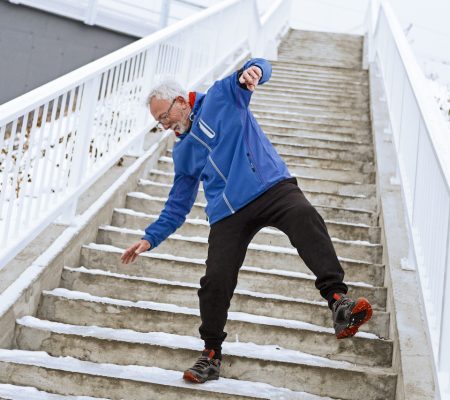3 Tips for Preventing Hand and Wrist Injuries from Winter Falls
Winter is here, and with all the holiday joy and fluffy show comes the dreaded instability of ice and slippery conditions. Slips and falls are a leading cause of hand and wrist injuries, and we see most of them during the icy winter months.
Why hand and wrist injuries? Hands and wrists are often susceptible to winter injuries when we “catch” ourselves during an unsteady landing after a slip. Even the most careful people can step on a patch of ice and have a winter slip and fall. That’s why it’s essential to keep up your bone health and take steps to prevent hand and wrist injuries before they happen.
Should you experience a hand or wrist injury, our experts at the Orthopaedic Hospital of Wisconsin are here to help you recover. In the meantime, OHOW physical therapists Jordan Ruedt, PT, DPT and Michele Gross, PT, DPT, COMT share their tips for preventing hand and wrist injuries from winter slips and falls.
1. Keep Your Bones Strong
 Bone health is especially important for preventing hand and wrist injuries. Even if you sustain the impact of a slip and fall, strong bones will prevent fractures and help you quickly recover.
Bone health is especially important for preventing hand and wrist injuries. Even if you sustain the impact of a slip and fall, strong bones will prevent fractures and help you quickly recover.
-
Stay physically active.
Staying physically active at any age will benefit not only your bone health but your health overall. Better still, strength-building exercises don’t need to take up much time. Doing simple exercises for just 20 minutes a day can help to improve your balance, stability, and reflexes. Keeping your wrists and hands flexible and stable is key to avoiding any serious injury during a slip, fall, or accident.
“A great way to improve your overall bone health is strength training focused on weight-bearing exercises such as squats, calf raises, and planks,” Gross said. Focus on strengthening and stretching the hands and wrists, as well as your upper body, to ensure you’re able to support your weight in the event of a fall.
-
Support bones with a healthy diet.
Your diet is an essential contributor to bone health. Nutrients, vitamins, and minerals help our bodies stay strong. Calcium is a particularly important mineral that our bodies store in the bones.
“Maintaining a healthy diet filled with calcium-rich foods such as dark leafy greens, oranges, almonds, yogurt, cheese, and soybeans, can improve your bone density and bone strength,” Gross said.
Vitamin D is a hormone that helps us absorb calcium, so it’s essential to get enough in our diets. Some people find taking calcium and vitamin D supplements are helpful. However, we recommend consulting with your primary care provider before taking any dietary supplements.
2. Use Help to Prevent Hand and Wrist Injuries
There’s no shame in support. Even the nimblest athletes can benefit from using the right equipment, and when winter weather gets slick, we all need to steady ourselves.
-
Use guard rails, assistive devices, or a helping hand.
Check your surroundings before you venture out on an icy sidewalk or stairway. Perhaps a guard rail is available to help you stay steady. If you struggle a bit with balance, it may also be beneficial to use an assistive device.
Keep in mind that using a cane or walker when traversing through unstable winter environments might help prevent a fall and subsequent hand and wrist injury, even if balance isn’t an issue during warmer weather. If you don’t have a device or guard rail available, ask for a helping hand. Lean on those who are stable and well-balanced to keep you upright in perilous footing!
-
Choose supportive footwear.
What you put on your feet greatly helps your stability on icy ground. Whenever possible, wear shoes with thick rubber soles and plenty of traction, especially in the winter. Avoiding heels, soft leather soles, and low traction shoes in slippery conditions will help you put your best (most stable) foot forward. If you’re feeling wobbly or experience foot pain, custom foot orthotics—shoe inserts for the comfort of your foot—might be the key to a solid and confident stride.
“Shoes that provide proper arch support help improve balance and reduce your risk of falling. Over-the-counter or custom orthotics are also a great option to improve foot and arch stability; you can use them in a variety of shoes.” Gross said. “However, I recommend consulting with a medical professional (physical therapist, orthotist, or podiatrist) to ensure the orthotic is the right fit for you!”
3. Work with a Physical Therapist
 If you’ve experienced past injuries or are recovering from any situation that may make you unsteady on your feet, reach out to a professional. Physical therapists will develop a plan to move comfortably without fear of injury.
If you’ve experienced past injuries or are recovering from any situation that may make you unsteady on your feet, reach out to a professional. Physical therapists will develop a plan to move comfortably without fear of injury.
-
Address the pain and build strength now.
If you’re in pain or experiencing increased weakness, you’re at a higher risk for further injury. A physical therapist can help you build strength, address discomfort, and avoid slips and falls that lead to hand and wrist injuries. An orthopedic professional will address the underlying cause of your pain or weakness. Hands and wrists are particularly prone to several injuries and conditions like osteoporosis, arthritis, and carpal tunnel syndrome.
“Some wrist and hand pains can also be coming from structures higher up on the body, like the shoulder, neck, or elbow,” Reudt said. “A physical therapist can help you decipher different symptoms and pain management.”
-
Avoid repeat injuries.
If you’ve fallen in the past, and especially if you were injured, you’re more likely susceptible to future falls. A physical therapist can provide you with expert advice on why you may be prone to falls that lead to hand and wrist injuries.
“Balance is one of the first aspects of mobility that deteriorate as we age, but balance is vital to practice and maintain, especially during the winter season,” Reudt said. Engaging with a professional will help you restore and improve your balance, to keep you upright even in treacherous conditions.
If you’re ready to protect your hands and wrists from injuries during winter slips and falls, make an appointment with one of our talented physical therapists today. We’ll help you develop a plan to stay safe and stable on your feet, no matter the weather.








